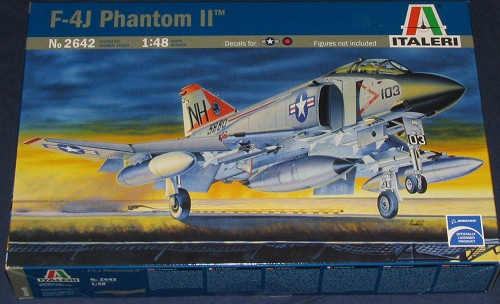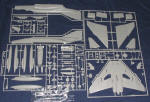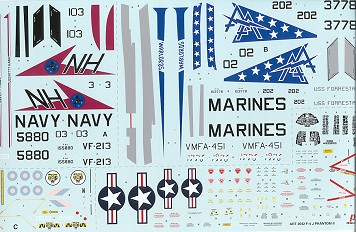
| KIT: | Italeri 1/48 F-4J Phantom II |
| KIT #: | 2642 |
| PRICE: | $36.00 MSRP |
| DECALS: | Three options |
| REVIEWER: | Scott Van Aken |
| NOTES: | Reboxed ESCI kit |

| HISTORY |
The very brief history given in the instructions says that the F-4 Phantom II is an aviation legend. Got that right. In terms of numbers produced, the 5000+ F-4s ranks below the 10,000 F-86s; 8,000 (estimated) MiG-21s; 7,500+ F-84s; 7,000+ MiG-17s; and 5,500 MiG-15 (some Russian sources say 18,000). However, these were all relatively simple single engine aircraft. The F-4 was a much more complex and faster twin engine aircraft with a crew of two.
Developed as a naval fleet defense interceptor and first flying in 1958, the F-4 eschewed the 'obsolete' gun for an array of short range Sidewinder and medium range Sparrow missiles. While great for knocking down bombers, these were not quite as good at plunking small, maneuverable fighters, an area where a gun would be considered an asset. Regardless, the majority of enemy fighters knocked down by F-4s were done with the Sidewinder, even after F-4s gained a gun with the last USAF variant.
The F-4J was an improved version of the F-4B. It was a slightly cleaner design and carried over many of the airframe components from the USAF's F-4D, combined with a more powerful pair of J-79 engines. Avionics were also significantly upgraded over previous versions. The F-4J was later modified to F-4S standards with 'smokeless' engines and slatted wing leading edges for greater maneuverability and even better low speed handling. The last USN F-4s were the QF-4S versions operated out of NAS Point Mugu, which were finally sent to rest in 2003/4.
| THE KIT |
 This
is a reboxing of the older ESCI F-4 kit. It has nicely engraved panel lines
and pretty decent overall detailing, including some wheel well detail.
However, it is still a child of the 80s with a rather bare cockpit, shallow
intakes, and an even shallower exhaust which is really no more than burner
cans.
This
is a reboxing of the older ESCI F-4 kit. It has nicely engraved panel lines
and pretty decent overall detailing, including some wheel well detail.
However, it is still a child of the 80s with a rather bare cockpit, shallow
intakes, and an even shallower exhaust which is really no more than burner
cans.
Detail in the cockpit (which is more for a USAF Phantom than a USN version) is raised detail on the side consoles and on the instrument panels. Decals are provided as well. The seats are representations of the Martin Baker versions used in the F-4. The look of the cockpit would be greatly improved by replacements in resin. The transparencies are well done and are separate so you can display them in the open position should you wish.
The molds have held up well over the years. There are some injector pin markings inside intakes, gear doors, landing gear legs, missile bodies, and a few other spots that will need removed. I saw no sink areas during the brief inspection of the parts. Flash is nearly non-existent on my kit as well.
The wing is the bulged version as used on all F-4s aside from the F-4B/N variant. This is the 'hard' wing with no leading edge slats. The tail planes have slotted edges as is proper for a USN bird and no reinforcement wedge as seen on USAF aircraft. Some of the additional bits included in the kit are side ECM antennas (which were used on some F-4Js very late in their career before being converted to F-4S standards), as well as the two lower nose seekers for the F-4B and F-4C. You also have two sets of burner cans provided, though the set for the F-4J seems a tad short to my eyes. Both USAF and USN inner pylons are provided so you have set for the spares box.
Things under the wings consist of a trio of drop tanks with the pylons molded in place, four Sidewinders, and four Sparrows. There are very large slots under the wing for the tanks and pylons. The trouble comes in that USN Phantoms did not often carry the wing drop tanks as the stress of catapult launches was such that these could, and sometimes did, fall off. Rarely would you see a Navy Phantom so fitted as shown on the box art. This means some major filling of these slots with plastic card and filler if you do not install the tanks on your kit.
 The instructions are up to
Italeri's usual high standards with nicely done construction drawings and
color references in generic, FS 595 and Model Master callouts. There are
markings for three planes on the huge decal sheet. The sheet is so large it
won't all fit on my scanner bed. One is for the box art plane from VF-213
in Light Gull Grey and White. There is also a very nice VMFA-451 aircraft
also in those colors. The third option is for an F-4J(UK) of 74 Squadron.
This last aircraft is supposed to be painted in FS 36440/35237 upper and FS
35237 undersides. The actual colors are BS 626 (Camouflage Grey)/637(Medium
Sea Grey) over 627(Light Aircraft Grey). When originally painted at
NAS North Island, they were in shades that had a decidedly greenish tint to
them. When later repainted in the UK they were given standard RAF shades as
listed above. The slime lights are way too yellow and should be replaced if
you have any that are more green in shade. The decal sheet is very well
printed and provides full data markings as well as wing walk and fuselage
walkway decals.
The instructions are up to
Italeri's usual high standards with nicely done construction drawings and
color references in generic, FS 595 and Model Master callouts. There are
markings for three planes on the huge decal sheet. The sheet is so large it
won't all fit on my scanner bed. One is for the box art plane from VF-213
in Light Gull Grey and White. There is also a very nice VMFA-451 aircraft
also in those colors. The third option is for an F-4J(UK) of 74 Squadron.
This last aircraft is supposed to be painted in FS 36440/35237 upper and FS
35237 undersides. The actual colors are BS 626 (Camouflage Grey)/637(Medium
Sea Grey) over 627(Light Aircraft Grey). When originally painted at
NAS North Island, they were in shades that had a decidedly greenish tint to
them. When later repainted in the UK they were given standard RAF shades as
listed above. The slime lights are way too yellow and should be replaced if
you have any that are more green in shade. The decal sheet is very well
printed and provides full data markings as well as wing walk and fuselage
walkway decals.
| CONCLUSIONS |
Overall, you can make a nice F-4J model out of this kit. Though it has been surpassed in terms of detail by the Hasegawa boxings, I have built several of these in the past and the results have been good.
December 2005
Thanks to
 for the review kit. You can find Italeri kits at your favorite hobby shop
or on-line at
www.testors.com
for the review kit. You can find Italeri kits at your favorite hobby shop
or on-line at
www.testors.com
If you would like your product reviewed fairly and fairly quickly by a site that has nearly 300,000 visitors a month, please contact me or see other details in the Note to Contributors.